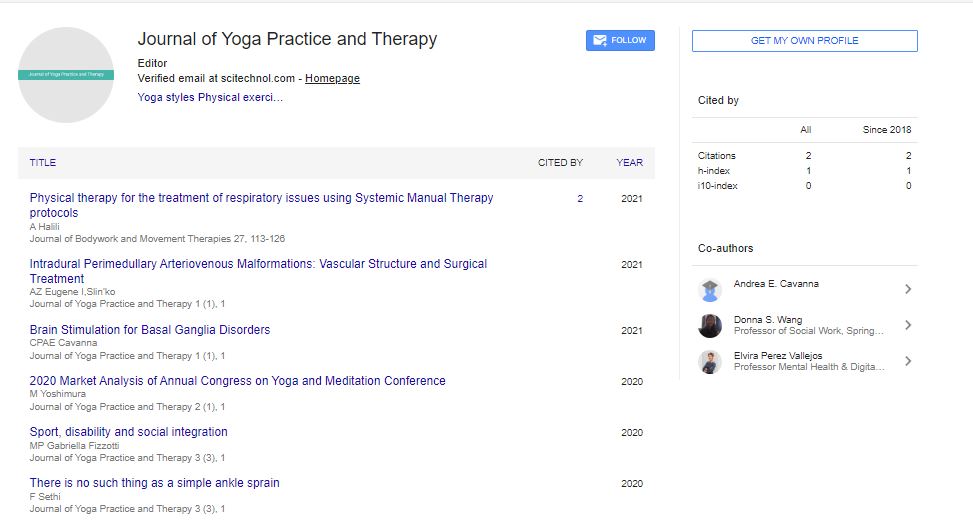Perspective, Vol: 6 Issue: 1
Comprehensive Examination of the Influence of Rotor Solidity on Vertical-Axis Wind Turbine Performance and Aerodynamics
Huan Li*
Department of Mechanical and Aerospace Engineering, Monash University, PO Box 31, 3800, Australia
*Corresponding Author: Huan Li
Department of Psychology, Department of
Mechanical and Aerospace Engineering, Monash University, PO Box 31, 3800, Australia
E-mail: HuanLi@theaustralian.com.au
Received date: 27 February, 2023, Manuscript No JYPTY-23-94072;
Editor assigned date: 01 March, 2023, Pre QC No. JYPTY-23-94072 (PQ);
Reviewed date: 15 March, 2023, QC No. JYPTY-23-94072;
Revised date: 22 March, 2023, Manuscript No. JYPTY-23-94072 (R);
Published date: 29 March, 2023, DOI: 10.4172/jypty.1000108
Citation: Li H (2023) Comprehensive Examination of the Rotor Solidity Influence on Vertical-Axis Wind Turbine Performance and A erodynamics. Int J Yoga Therap 6:1.
Description
Vertical-Axis Wind Turbines (VAWTs) are becoming increasingly popular for generating renewable energy due to their unique ability to capture wind energy from any direction without the need for complex yawing systems. One of the critical design parameters affecting VAWT performance is rotor solidity, which is defined as the ratio of the total blade area to the swept area of the rotor.
The influence of rotor solidity on VAWT performance and aerodynamics has been extensively investigated through experimental and numerical studies. The results indicate that the choice of rotor solidity has a significant impact on turbine performance, including power output, torque, and efficiency. For low solidity rotors, the blades are spaced far apart, resulting in low blockage and reduced drag, making them suitable for low wind speed regions. However, they also produce low power output due to lower blade area. In contrast, high solidity rotors have closely spaced blades and higher blade area, resulting in high blockage and increased drag, making them suitable for high wind speed regions. However, they also produce higher power output at the expense of lower efficiency.
Several factors influence the choice of rotor solidity, including wind speed, blade profile, and blade number. Generally, high solidity rotors with two or three blades are more efficient at higher wind speeds, while low solidity rotors with four or more blades are more effective at low wind speeds. The blade profile also influences rotor solidity, with thicker blades resulting in higher solidity. Numerical simulations, such as Computational Fluid Dynamics (CFD), are commonly used to investigate the aerodynamics of VAWTs with different rotor solidities. The results of these simulations can provide insights into the flow behavior around the blades, including wake formation and vortex shedding. Additionally, experimental studies, such as wind tunnel tests and field measurements, can be used to validate the numerical results.
The rotor solidity is a critical design parameter that significantly affects VAWT performance and aerodynamics. The choice of rotor solidity depends on several factors, including wind speed, blade profile, and blade number. Numerical simulations and experimental studies can provide insights into the flow behavior around the blades and help in selecting an optimal rotor solidity for VAWT applications. The aerodynamics of wind turbines is the study of how wind interacts with the turbine blades. The blades are designed to maximize the amount of energy that can be extracted from the wind while minimizing turbulence, drag, and noise. There are several factors that affect the aerodynamics of wind turbines, including the shape of the blades, their angle of attack, and the wind speed. The performance of a wind turbine is measured by its power output, which is affected by several factors, including the wind speed, the size and shape of the blades, and the efficiency of the generator. Wind turbines are designed to operate optimally at a specific wind speed, known as the rated wind speed. If the wind speed is too low, the turbine may not generate enough power to be economical, while if the wind speed is too high, the turbine may shut down to prevent damage.
To optimize the performance and aerodynamics of wind turbines, engineers use computer simulations and wind tunnel testing to study the behavior of wind and the interaction with the blades. They also use advanced materials and manufacturing techniques to make the blades lighter, stronger, and more aerodynamic.
 Spanish
Spanish  Chinese
Chinese  Russian
Russian  German
German  French
French  Japanese
Japanese  Portuguese
Portuguese  Hindi
Hindi 